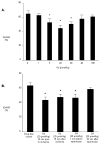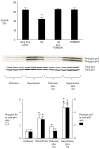Gadolinium limits myocardial infarction in the rat: dose-response, temporal relations and mechanisms
- PMID: 18083188
- PMCID: PMC2322938
- DOI: 10.1016/j.yjmcc.2007.11.002
Gadolinium limits myocardial infarction in the rat: dose-response, temporal relations and mechanisms
Abstract
The lanthanide cation, gadolinium (Gd) attenuates post-ischemic myocardial stunning. This study tests the hypothesis that Gd also preconditions the myocardium against infarction following ischemia-reperfusion (IR) and explores potential mechanisms underlying Gd-induced cardioprotection. Regional myocardial infarction was induced in rats by occluding the left anterior descending artery for 30 min and reperfusing for 120 min. Rats (n=6/group) were administered intravenous Gd (1 to 100 micromol/kg) 15 min prior to ischemia. Hearts were excised after reperfusion to determine infarct size (IS) and area at risk (AAR). The ratio IS/AAR (%) was reduced by Gd in a "U"-shaped, dose-dependent manner. The minimum dose that reduced IS/AAR was 5 micromol/kg (52+/-5% vs. 64+/-4%), while the dose that reduced IS/AAR maximally was 20 micromol/kg (44+/-4%). Gd also reduced IS/AAR when given 1 min before reperfusion (47+/-3%) but not when given 10 s after reperfusion (60+/-3%). Cardioprotection was maintained if IR was delayed 24-72 h after Gd administration. Cardioprotection by Gd was abolished by inhibition of JAK-2 with AG-490, of p42/44 MAPK with PD98059 or of K(ATP) channels with glibenclamide. None of these agents given alone altered IS/AAR compared with controls. Inhibition of JAK-2 also blocked Gd-induced delayed cardioprotection. Gd may have broad potential roles in IR, as it conferred immediate cardioprotection when given prior to ischemia or prior to reperfusion and delayed cardioprotection for up to 72 h after administration. The mechanism underlying Gd-induced preconditioning appears to be multi-factorial, involving JAK-2, STAT-3 and p44 MAPK pathways, as well as K(ATP) channels.
Figures







Similar articles
-
Morphine postconditioning protects against reperfusion injury in the isolated rat hearts.J Surg Res. 2008 Apr;145(2):287-94. doi: 10.1016/j.jss.2007.07.020. Epub 2007 Aug 23. J Surg Res. 2008. PMID: 18155248
-
Darbepoetin alfa protects the rat heart against infarction: dose-response, phase of action, and mechanisms.J Cardiovasc Pharmacol. 2007 Jun;49(6):337-45. doi: 10.1097/FJC.0b013e318040cf81. J Cardiovasc Pharmacol. 2007. PMID: 17577097
-
Activation of kappa-opioid receptors at reperfusion affords cardioprotection in both rat and mouse hearts.Basic Res Cardiol. 2008 Sep;103(5):454-63. doi: 10.1007/s00395-008-0726-z. Epub 2008 May 23. Basic Res Cardiol. 2008. PMID: 18500486
-
SCH 79797, a selective PAR1 antagonist, limits myocardial ischemia/reperfusion injury in rat hearts.Basic Res Cardiol. 2007 Jul;102(4):350-8. doi: 10.1007/s00395-007-0653-4. Epub 2007 Apr 30. Basic Res Cardiol. 2007. PMID: 17468933 Free PMC article.
-
[Involvement of potassium channel in hemin-induced cardioprotection in rat hearts].Zhejiang Da Xue Xue Bao Yi Xue Ban. 2007 Jan;36(1):7-12. doi: 10.3785/j.issn.1008-9292.2007.01.002. Zhejiang Da Xue Xue Bao Yi Xue Ban. 2007. PMID: 17290485 Chinese.
Cited by
-
Update on the Pathophysiological Role of Intracellular Signaling Pathways in Atherosclerotic Plaques and Ischemic Myocardium.Curr Signal Transduct Ther. 2012 May;7(2):104-110. doi: 10.2174/157436212800376663. Curr Signal Transduct Ther. 2012. PMID: 22754427 Free PMC article.
-
Gadolinium decreases inflammation related to myocardial ischemia and reperfusion injury.J Inflamm (Lond). 2009 Dec 10;6:34. doi: 10.1186/1476-9255-6-34. J Inflamm (Lond). 2009. PMID: 20003243 Free PMC article.
-
Gadolinium Chloride Restores the Function of the Gap Junctional Intercellular Communication between Hepatocytes in a Liver Injury.Int J Mol Sci. 2019 Jul 31;20(15):3748. doi: 10.3390/ijms20153748. Int J Mol Sci. 2019. PMID: 31370360 Free PMC article.
-
Gadolinium-promoted cell cycle progression with enhanced S-phase entry via activation of both ERK and PI3K signaling pathways in NIH 3T3 cells.J Biol Inorg Chem. 2009 Feb;14(2):219-27. doi: 10.1007/s00775-008-0442-z. Epub 2008 Oct 25. J Biol Inorg Chem. 2009. PMID: 18953580
-
Effect of dimerized thrombin fragment TP508 on acute myocardial ischemia reperfusion injury in hypercholesterolemic swine.J Pharmacol Exp Ther. 2010 Aug;334(2):449-59. doi: 10.1124/jpet.110.166348. Epub 2010 May 11. J Pharmacol Exp Ther. 2010. PMID: 20460385 Free PMC article.
References
-
- Nicolosi AC, Kwok CS, Contney SJ, Olinger GN, Bosnjak ZJ. Gadolinium prevents stretch-mediated contractile dysfunction in isolated papillary muscles. Am J Physiol Heart Circ Physiol. 2001;280:H1122–8. - PubMed
-
- Nicolosi AC, West G, Markley JG, Logan B, Olinger GN. Gadolinium attenuates regional stunning in the canine heart in vivo. J Thorac Cardiovasc Surg. 2002;124:57–62. - PubMed
-
- Nicolosi AC, Kwok CS, Logan B. Effects of gadolinium on regionally stunned myocardium: temporal considerations. J Surg Res. 2007;139:286–91. - PubMed
-
- Nicolosi AC, Kwok CS, Bosnjak ZJ. Antagonists of stretch-activated ion channels restore contractile function in hamster dilated cardiomyopathy. J Heart Lung Transplant. 2004;23:1003–7. - PubMed
-
- Gysembergh A, Margonari H, Loufoua J, Ovize A, Andre-Fouet X, Minaire Y, et al. Stretch-induced protection shares a common mechanism with ischemic preconditioning in rabbit heart. Am J Physiol. 1998;274:H955–64. - PubMed
Publication types
MeSH terms
Substances
Grants and funding
LinkOut - more resources
Full Text Sources
Medical
Miscellaneous

